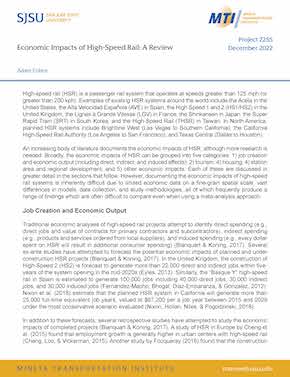- 408-924-7560
- mineta-institute@sjsu.edu
- Donate
Economic Impacts of High-Speed Rail: A Review
The study evaluates the economic impacts of High-speed rail (HSR) using a meta-analysis approach. HSR is a passenger rail system that operates at speeds greater than 125 mph (or greater than 200 kph). Broadly, the economic impacts of HSR can be grouped into five categories: 1) job creation and economic output (including direct, indirect, and induced effects); 2) tourism; 4) housing; 4) station area and regional development; and 5) other economic impacts. A number of studies have also attempted to quantify economic impacts associated with time savings, reduced congestion, and lower emissions (pollution and greenhouse gas (GHG)). An increasing body of literature documents the economic impacts of HSR, although more research is needed. Documenting the economic impacts of high-speed rail systems is inherently difficult due to limited fine-grained economic data, and differences in models, data collection, and study methodologies, which frequently produce inconsistent findings. Most existing studies were also completed before the pandemic and therefore fail to account for other changes in travel behavior such as the growth of telework. As travel behavior continues to stabilize in the post-pandemic period, high-speed rail may have to reinvent itself in response to these changes in order to maximize potential economic benefits.
ADAM COHEN
Adam Cohen is an MTI Research Associate and a researcher at the Transportation Sustainability Research Center at the University of California, Berkeley. Since joining the group in 2004, his research has focused on innovative mobility, including shared mobility, smart cities technologies, smartphone apps, automated and connected vehicles, urban air mobility, and other emerging transportation technologies. He has also co-authored numerous peer-reviewed articles and reports on innovative mobility.
-
Contact Us
San José State University One Washington Square, San Jose, CA 95192 Phone: 408-924-7560 Email: mineta-institute@sjsu.edu






